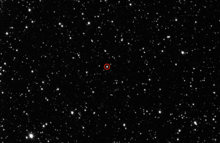KIC 9832227

| Observation data Epoch J2000 Equinox J2000 | |
|---|---|
| Constellation | Cygnus |
| Right ascension | 19h 29m 15.948s[1] |
| Declination | +46° 37′ 19.89″[1] |
| Apparent magnitude (V) | 12.27 – 12.46[2] |
| Astrometry | |
| Distance | 1843 ly (565[3] pc) |
| Orbit[3] | |
| Period (P) | 0.45796151 days |
| Semi-major axis (a) | 2.992 R☉ |
| Inclination (i) | 53.2° |
| Periastron epoch (T) | 2455688.49913 |
| Details[3] | |
| A | |
| Mass | 1.395 M☉ |
| Radius | 1.581 R☉ |
| Luminosity | 2.609 L☉ |
| Surface gravity (log g) | 4.19 cgs |
| Temperature | 5800 K |
| Rotational velocity (v sin i) | 149.7 km/s |
| B | |
| Mass | 0.318 M☉ |
| Radius | 0.830 R☉ |
| Luminosity | 0.789 L☉ |
| Surface gravity (log g) | 4.10 cgs |
| Temperature | 5920 K |
| Rotational velocity (v sin i) | 84.7 km/s |
| Other designations | |
| Database references | |
| SIMBAD | data |
| KIC | data |
KIC 9832227 is a contact binary star system[4] in the constellation Cygnus, located about 1,940 (± ~30) light-years away.[5] It is also identified as an eclipsing binary with an orbital period of almost 11 hours.[4] In 2017, the system was predicted to result in a merger in 2022.2 (± 0.6 years), producing a luminous red nova (LRN) reaching an apparent magnitude of 2.[5] The LRN would remain visible to the naked eye for roughly a month. The merger of the two stellar cores was predicted to give birth to a new, hotter, more massive main-sequence star. However, a reanalysis of the data in September 2018 revealed that the prediction had been based on a wrongly timed observation, negating the predicted merger.[6][7][8]
The period of the variations in KIC 9832227 has been observed to be growing shorter since 2013. It is expected that the period will continue to get smaller at an ever-increasing rate, and end in the merging of the two cores. This will release a very large amount of energy, a process which occurred before in the system V1309 Scorpii, a nova which erupted in 2008, and was later found by a team led by Romuald Tylenda to have been the result of a stellar merger. However, astronomers in Tylenda's team have questioned the reliability of the KIC 9832227 prediction, because it is based on a model that may not be accurate enough to predict the eruption time so precisely.[9] The physical mechanism or mechanisms driving such stellar mergers is still not understood, and is the main focus of those researching KIC 9832227.
In September 2018, it was announced that the original prediction was based on a timing offset of 12 hours in one of the datasets. This shows that the period had actually been increasing up to about 2008. The cause for the period variation is still unknown, but it is unlikely that the system will end in a merger at the predicted time.[6][7][10]
See also
References
- 1 2 Cutri, R. M. (2003). "2MASS All-Sky Catalog of Point Sources". VizieR On-line Data Catalog. 2246. Bibcode:2003yCat.2246....0C.
- ↑ "ASAS J192916+4637.3". AAVSO. Retrieved 7 January 2017.
- 1 2 3 Molnar, Lawrence A.; Van Noord, Daniel M.; Steenwyk, Steven D.; Spedden, Chris J.; Kinemuchi, Karen (2015). "A prediction of a luminous red nova eruption" (PDF). American Astronomical Society. 225 (225): 415.05. Bibcode:2015AAS...22541505M. Archived from the original (PDF) on 7 January 2017.
- 1 2 Kinemuchi, Karen (2013-10-01). "To Pulsate or to Eclipse? Status of KIC 9832227 Variable Star". 1310: arXiv:1310.0544. arXiv:1310.0544. Bibcode:2013arXiv1310.0544K.
- 1 2 Molnar, Lawrence A.; Van Noord, Daniel; Kinemuchi, Karen; Smolinski, Jason P.; Alexander, Cara E.; Kobulnicky, Henry A.; Cook, Evan M.; Jang, Byoungchan; Steenwyk, Steven D. (2017). "KIC 9832227: A red nova precursor". American Astronomical Society. 229: 417.04. Bibcode:2017AAS...22941704M.
- 1 2 Molnar, Lawrence A. (7 September 2018). "Supplementary material to Calvin College press release "Team of researchers challenge bold astronomical prediction", September 7, 2018". calvin.edu. Retrieved 8 September 2018.
- 1 2 Kucinski, Matt (7 September 2018). "Team of researchers challenge bold astronomical prediction". calvin.edu. Retrieved 8 September 2018.
- ↑ Parks, Jake (7 September 2018). "Two stars will NOT merge and explode into red fury in 2022". astronomy.com.
- ↑ Carlisle, Camille (6 January 2017). "Paired Stars in Cygnus En Route to Merger". Sky and Telescope. Retrieved 12 January 2017.
- ↑ Socia, Quentin J.; Welsh, William F.; Short, Donald R.; Orosz, Jerome A.; Angione, Ronald J.; Windmiller, Gur; Caldwell, Douglas A.; Batalha, Natalie M. (11 September 2018). "KIC 9832227: Using Vulcan Data to Negate the 2022 Red Nova Merger Prediction". Astrophysical Journal Letters.
External links
- Molnar, Lawrence; et al. (4 January 2017). "Prediction of a Red Nova Outburst in KIC 9832227" (PDF). Calvin College (draft ed.). Calvin College Group. Archived from the original (PDF) on 7 January 2017. Retrieved 8 January 2017.
- Knapton, Sarah. "Spectacular collision of suns will create new star in night sky in 2022". The Daily Telegraph. Telegraph Media Group. Retrieved 7 January 2017.
- Byrd, Deborah. "Star predicted to explode in 2022". EarthSky. EarthSky Communications. Retrieved 7 January 2017.
- Masi, Gianluca. "Star merging in KIC 9832227: a possible once-in-a-lifetime event". Virtual Telescope Project. Virtual Telescope Project. Retrieved 11 January 2017.